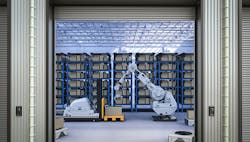Richard Vaughn is automation engineering manager at Bosch Rexroth.
Which technologies have allowed warehouses to increase throughput rates while expanding product ranges and still maintaining accurate order fulfillment?
Richard Vaughn, automation engineering manager at Bosch Rexroth: Robots such as Cartesians, gantries and six-axis styles have helped increase warehouse throughput rates as they can handle various sizes and weights of products to accurately fulfill orders.
Also read: Warehouses continue to improve efficiency with collaborative robots, AMRs and AGV technology
How have automated storage and retrieval systems' roles changed over the past 10 years?
Richard Vaughn, automation engineering manager at Bosch Rexroth: Ten years ago, automated storage and retrieval systems typically required manual input from an operator who then would wait on a part to be delivered. However, today, most systems accept automated input so that a part can not only be delivered, but also, when conveyance or robots are utilized, can be picked up and taken to its next operation without operator intervention. This often removes mundane tasks, allowing workers to focus on more critical ones with increased efficiency for companies.
Will autonomous mobile robots replace automated guided vehicles altogether, or is there room for both, based on the application or complementary functions?
Richard Vaughn, automation engineering manager at Bosch Rexroth: Depending on the applications, there’s room for both, but most likely autonomous mobile robots will have a higher usage as there’s often more flexibility working in conjunction with the human workforce.
How will ANSI/RIA R15.08 affect robotic solutions in warehouse environments?
Richard Vaughn, automation engineering manager at Bosch Rexroth: This safety standard will help drive more collaborative efforts to utilize the current workforce at companies working alongside and with the workers.
Given the extraordinary percentage of manual operation in most distribution centers, will the 24/7 fully autonomous warehouse order-fulfillment center ever become commonplace?
Richard Vaughn, automation engineering manager at Bosch Rexroth: While fully autonomous warehouses would be ideal, there will always be a need for manual operations. That being the case, a 24/7 fully automated warehouse wouldn’t be commonplace, but a majority-automated one very well could be.
Mike Bacidore is the editor in chief for Control Design magazine. He is an award-winning columnist, earning a Gold Regional Award and a Silver National Award from the American Society of Business Publication Editors. Email him at [email protected].
About the Author
Mike Bacidore
Editor in Chief
Mike Bacidore is chief editor of Control Design and has been an integral part of the Endeavor Business Media editorial team since 2007. Previously, he was editorial director at Hughes Communications and a portfolio manager of the human resources and labor law areas at Wolters Kluwer. Bacidore holds a BA from the University of Illinois and an MBA from Lake Forest Graduate School of Management. He is an award-winning columnist, earning multiple regional and national awards from the American Society of Business Publication Editors. He may be reached at [email protected]

Leaders relevant to this article:



